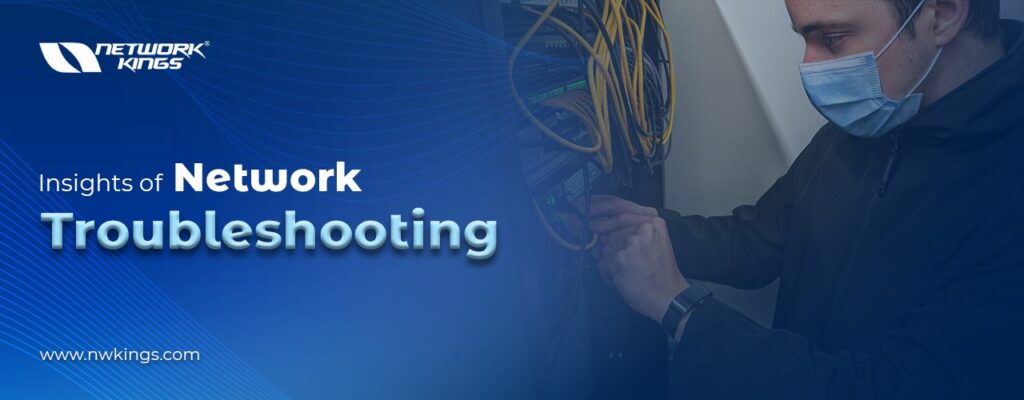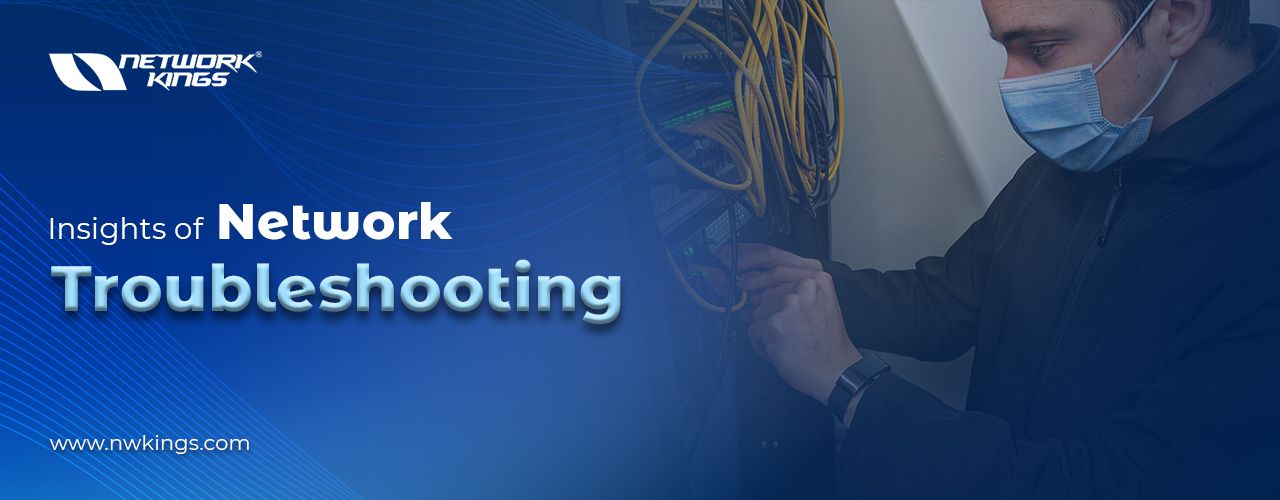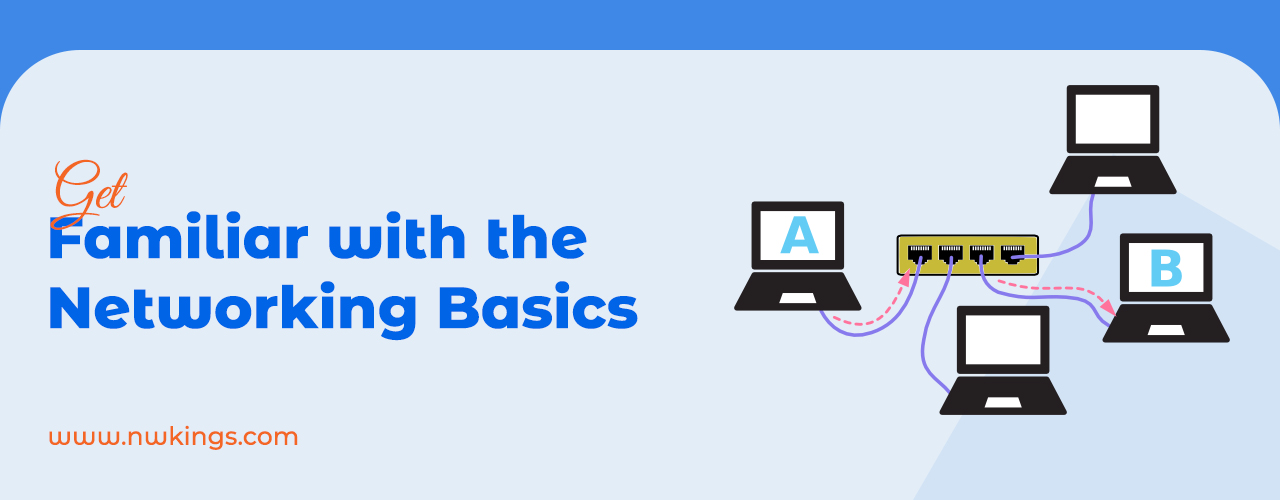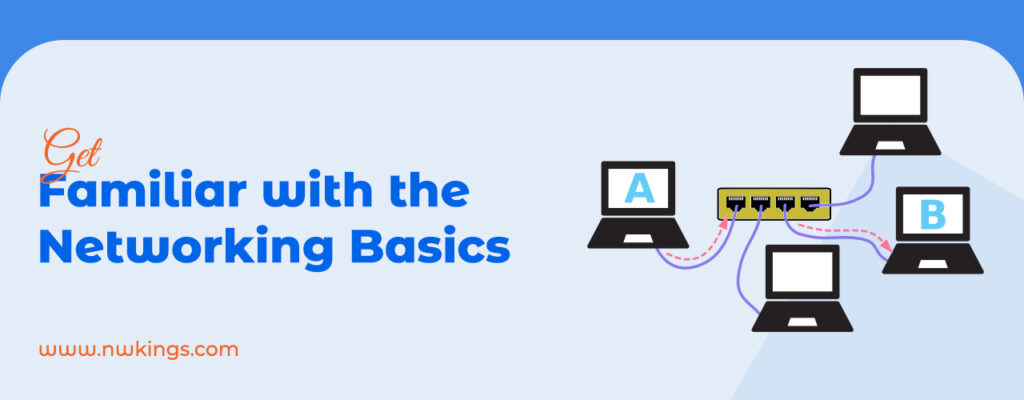
Basic knowledge of Network Troubleshooting Tools is a must for everyone because anyone can go through network issues. Network issues are daunting. Suppose you are uploading very crucial data, and suddenly your connection loses connectivity. Sounds scary, right?
Hence, you must possess Network Troubleshooting knowledge to avoid such blunders in your system. But how? Is everyone eligible for getting Network Troubleshooting training?
All these queries will have answers in the blog. Keep engaged till the end.
What is Network Troubleshooting?
The term troubleshooting directs the learner to identify problems with a network through a relentless and noteworthy process and then decoding those problems using testable methods.
Troubleshooting is more practical than attempting things spontaneously until the network functions because it permits you to target particular network components, experimenting with each for operation, and facilitates you to document your process.
Network troubleshooting is valuable for almost anyone, from a computer enthusiast to a desiring Network Engineer.
What is the importance of Network Troubleshooting?
Network troubleshooting is crucial as it enables IT managers to comprehend network component problems, lessen downtime, and enhance the network’s Quality of Service (QoS) for users.
With an adequate and reliable network monitoring system, it is more comfortable to troubleshoot problems, specify network downshift quickly, research latency metrics, trace packets, and more.
Besides troubleshooting, network monitoring systems supervise network configurations and mark essential metrics, such as packet data and proficiency to confirm smooth business-critical processes.
What are the causes of Network Troubleshooting?
There may not be a single cause of the Network Troubleshooting. Let us discuss some common causes of Network Troubleshooting:
High Bandwidth Usage
Higher bandwidth ensures transmitting data between devices over the internet. Downloading large files, shared folders, and video content forms congestion in the Network due to high bandwidth usage. It leads to network slowdown issues.
Faulty Hardware
One of the most common network performance issues is the malfunctioning of routers, switches, cables, and more. All devices on the network must be configured precisely and tested frequently to ensure the smooth functioning of the network.
High CPU Utilization
CPU usage increases drastically when more network packets are accepted and sent all over the network. A considerable amount of traffic also overfills the network and demands high CPU utilization to manage the demands.
Poor Physical Connectivity
It is essential to experiment with all cables since inferior cables can induce mistakes as they are connected straight to the interface of the network equipment. Cable damage can also escort to packet loss and the decrement of the amount of data flowing.
Basic Network Troubleshooting Tools that every IT Pro should know
Every system has a connection with multiple networks and systems through internal or external network channels. These network settings often operate into problems and impact the working of the system.
We can solve Networking issues with the help of Network Commands. These commands are designed to troubleshoot network problems with the lowest complexity using the Windows command prompt tool.
Next, let’s take a look at the top 10 Network Troubleshooting Tools:
Ping
Ping is a basic network troubleshooting tool used to test network connectivity between two devices. It sends an Internet Control Message Protocol (ICMP) echo request packet to a specific IP address or domain name and waits for a response. By measuring the time it takes for the packet to reach the destination and come back (round-trip time), ping can determine if a device or host is reachable and estimate network latency. Ping is widely used to diagnose network connectivity issues, test network performance, and verify if a remote device is accessible.
Traceroute
Traceroute is a network diagnostic tool used to trace the route packets take from a source device to a destination device or host. It sends a series of User Datagram Protocol (UDP) or Internet Control Message Protocol (ICMP) packets with incrementing Time-to-Live (TTL) values, which are progressively decremented by each router along the path. Each router that receives the packet sends back an ICMP Time Exceeded message, allowing traceroute to determine the IP addresses and round-trip times of each hop in the route.
Traceroute is useful for identifying network bottlenecks, troubleshooting connectivity issues, and determining the exact location where a network problem occurs.
Ipconfig/Ifconfig
Ipconfig (Windows) and ifconfig (Linux/Unix) are command-line tools used to display the IP configuration information of a network interface on a device. They provide details about the IP address, subnet mask, default gateway, DNS servers, and other network-related information.
Ipconfig and ifconfig are valuable for troubleshooting network connectivity issues, verifying IP configuration settings, and diagnosing problems related to IP address conflicts or misconfigurations.
Netstat
Netstat is a command-line tool available on various operating systems that provides information about active network connections, listening ports, and network statistics. It displays details such as the local and remote IP addresses, port numbers, protocol used, connection state, and process ID associated with each connection.
Netstat is useful for troubleshooting network-related issues like identifying open ports, monitoring network connections, detecting suspicious activity, and diagnosing performance problems caused by excessive network traffic or improper resource allocation.
Nslookup/Dig
Nslookup (Windows) and dig (Linux/Unix) are command-line tools used for querying the Domain Name System (DNS). They provide information about DNS records, such as IP addresses associated with domain names or vice versa.
Nslookup and dig allow IT professionals to troubleshoot DNS-related issues by querying DNS servers directly and verifying if DNS resolution is working correctly. They can be used to diagnose problems like incorrect DNS configurations, DNS cache issues, or domain name resolution failures.
PuTTY/Tera Term
PuTTY and Tera Term are popular terminal emulation programs that provide secure remote access to network devices using protocols like SSH, Telnet, and serial connections. These tools allow IT professionals to establish a command-line interface (CLI) session with network devices, enabling them to configure, manage, and troubleshoot devices remotely.
PuTTY and Tera Term offer features such as session logging, file transfer capabilities, and support for various encryption methods.
Subnet and IP Calculator
Subnet and IP calculators are tools used to calculate network subnetting and IP address information. These tools help IT professionals determine the subnet mask, network address, broadcast address, and available host addresses based on a given IP address and subnet mask. They are invaluable for designing and troubleshooting network subnets, ensuring efficient IP address allocation, and verifying network connectivity between subnets.
Speedtest.net/pingtest.net
Speedtest.net and pingtest.net are web-based tools that measure internet connection speed and quality respectively. Speedtest.net measures the download and upload speeds between a user’s device and a nearby server, providing insights into the overall internet connection performance.
Pingtest.net measures the latency or delay in milliseconds between a user’s device and a designated server, helping identify potential network congestion or packet loss issues. These tools are useful for assessing internet connection performance, troubleshooting slow network speeds, and determining if network issues are local or related to the internet service provider.
Pathping/mtr
Pathping (Windows) and mtr (Linux/Unix) are network diagnostic tools that combine the functionality of ping and traceroute utilities. They provide comprehensive information about the path packets take from a source to a destination, including round-trip times, packet loss, and hop-by-hop latency details. Pathping and mtr are particularly useful for troubleshooting intermittent connectivity issues, identifying network bottlenecks, and pinpointing specific routers or segments causing network problems.
Route
The route command is a network troubleshooting tool available on various operating systems, including Windows, Linux, and Unix. It allows IT professionals to view and manipulate the routing table on a device. The routing table contains information about how IP packets should be forwarded to their destinations.
By using the route command, IT professionals can add or delete routes, modify routing metrics, and troubleshoot routing-related issues such as incorrect or missing routes. The route command is essential in troubleshooting network connectivity problems caused by routing misconfigurations or inconsistencies.
What are the Key Concepts of Network Troubleshooting?
The key concepts of Network Troubleshooting are:
Identifying Network Issues
The major task of Network Troubleshooting is to identify network issues with the help of Networking tools.
Isolating the Source of Problems
Segregate the source of problems to identify the priority issue and solve it first.
Factors Affecting Network Performance
There are various factors affecting network performance. Network performance is about response time – how short a message is sent or how quickly a document can be retrieved. The performance of a network can be influenced by various factors:
- Devices on the network.
- The bandwidth of the transmission medium
- The type of network traffic
- Network latency
- The number of transmission errors
Any network can be impacted by one or a mixture of these factors.
Bandwidth is a measurement of the amount of data that the medium can transmit over a given period. Each transmission medium has a distinct bandwidth.
What are the types of Network Troubleshooting?
Network Troubleshooting is divided into three parts:
Hardware-related Issues
Network Troubleshooting can cause hardware-related issues like any of your hardware devices can get destroyed.
Software-related Issues
Network Troubleshooting also includes software-related issues, such as any software that can stop working suddenly. It is annoying but when the software stops working, and so is your work.
Connection and Configuration Problems
Ever gone through a problem where your wires are not connected, or the point stops working? It may be due to dust in the point or any other error.
Step-by-Step Guide: How to Troubleshoot Network Issues
Network Troubleshooting is not easy to handle, but here is a step-by-step guide to troubleshoot network issues:
Define the Problem
- Gathering User Feedback: Managing customer feedback offers you respect for their beliefs. By requesting your customers for feedback, you share that their thought is vital to you. You apply them in shaping your business, so they sense more attachment to your company. Attending to their voice allows you to build more vigorous ties with them.
- Examining Error Messages: Error messages are helpful when we need a user intervention that suggests a preferred process has failed or relays crucial warnings.
Inspect Hardware Connections
- Verifying Physical Connections: One must check your connections before starting the work to avoid Network Troubleshooting in the middle.
- Rebooting Devices: Rebooting devices will help you to remove the error. The device avoids lagging after rebooting devices.
Operate Networking Commands
- Testing Connectivity: Test your connectivity with the help of ping and traceroute to operate networking commands.
- Gathering Network Configuration Details: A network configuration in a centralized software interface, permitting you to configure, observe and allocate your Network properly.
Analyze Network Traffic
- Using Wireshark: You can analyze your network traffic with the help of the Wireshark tool. Wireshark permits you to filter the log before the capture begins or during research, so you can lessen and nil in on what you seek in the network trace.
- Identifying Abnormal Patterns: Network traffic analysis (NTA) monitors network availability and activity to specify anomalies, comprising security and functional problems. The function of NTA comprises organizing a real-time and historical record of what is occurring in your Network.
Isolate Software Issues
- Checking Firewall and Security Software: A firewall safeguards vulnerable systems and personal data in the Network from unauthorized entry, like cyberpunks or insiders.
- Investigating Application Interference: Performance isolation in virtual machines (VMs) directs to the ability to separate the temporal conduct of numerous VMs among each other, despite them driving on the same physical host and sharing a set of physical resources, like processors and memory.
Monitor Network Performance
- Using SolarWinds Network Performance Monitor: SolarWinds Network Performance Monitor (NPM) is a renowned automated network monitoring tool that allows discovery and monitoring across network devices, including devices, like firewalls, switches, and load balancers.
- Specifying Bandwidth Bottlenecks: Network bandwidth bottlenecks can drive to slow, unresponsive applications. As a result, they compromise network processes and could cease operations. Loss in productivity, finances, and customer satisfaction have probable negative side results.
Band with Network Professionals
- Seeking Help: Taking help from colleagues to collaborate with network professionals to handle network troubleshooting easily.
- Sharing Conclusions and Gathering Recommendations: Gather tips and conclusions to increase a better collaboration with Network Professionals.
Where to learn the Networking course?
Network Kings is the head of Networking. Here are the grounds to follow the Networking course in India from Network Kings:
- Networking: Interact and connect with our team to get help at every step of your career.
- Learn with the best: Learn from professional industry experts.
- Structured Learning: Network King’s curriculum is designed by professionals to deliver the best learning experience.
- Completion Certification: You will get certification on completing the course. It will improve your resume and career opportunities.
- World’s largest labs: 24/7 access to labs with zero downtime.
- Career Guidance: Career advice via career consultants.
- Tricks for Interviews: Tips and tricks to crack interviews and exams.
- Recorded lectures: Get access to the recorded lectures to comprehend at flexible hours progress.
What are the top Networking courses in IT?
Networking is thriving with the technological epoch. To join the networking field, one must go for the top courses. Network Certification course includes:
What skills will you learn in the networking course?
Skills one will learn in the networking course are:
- Working with Network firewall
- VPN- Virtual Private Network
- IPS
- IDS
- Protocol analysis
- IPse
- Networking Troubleshooting
What are the job opportunities after the Networking course?
The job opportunities after the Networking courses are:
- Technical Network Support Engineer
- Network Support Engineer
- Network Operations Center Engineer
- Desktop Support Engineer
- IT Support Engineer
- Hardware Network Engineer
- IT Assistant
- VoIP Engineer
- Network Assurance Engineer
- Wireless Network Engineer
- Customer Service Representative
- Network Engineer- 3 Fortinet
- Network Administrator
- Network Analyst- 2
- Network Activations Supervisor
- Electronics Technician Talent Network
- System Administrator
- Data Center Project Manager- IT/ Network
- Informaticist
What are the salary expectations after the Networking course?
The salary expectations after the Networking course are:
- United States – USD 74,565 and USD 93,514
- Canada – CAD 55,000
- United Kingdom – £ 30,000
- Germany – € 39,000
- France – € 42,000
- Italy – € 31,000
- Spain – € 32,000
- Australia – AUD 82,000
- New Zealand – NZ 43,000
- Japan – ¥ 58,000
- Singapore – S$ 40,000
- Brazil – R$ 48,000
- South Africa – ZAR 53,000
- United Arab Emirates – AED 7500
Conclusion
Mastering Network Troubleshooting needs practice. It is vital to stay updated with new tools and techniques. Why being up-to-date with industry trends and technological progress is crucial? Because it can help you remain forward of the arc.
By being mindful of the most delinquent developments in your industry, you can expect modifications and take bold steps to adjust to them.
Also, achieving a reliable and high-performing Network is mandatory.
A network with a correct set-up will help enhance your businesses through technology performance, lowering overall costs and allowing focus on your internal IT resources so you can concentrate on business growth industries rather than creating and managing network infrastructure.




